University Report: Business Research on Social Media Impact
VerifiedAdded on 2021/05/27
|9
|1686
|30
Report
AI Summary
This report delves into the real-world management implications of social media, highlighting its transformative impact on marketing. It explores the evolution of social media platforms, such as Facebook and YouTube, and their influence on customer buying behavior. The report identifies common themes, including increased customer awareness and direct communication channels, and different themes like creative interfaces and enhanced online customer engagement. It analyzes study limitations, such as data collection methods and sampling biases, and suggests future research directions. The conclusion emphasizes social media's role in customer awareness, marketing strategies, and fostering customer loyalty. The report uses secondary research, including academic journal articles, and provides a comprehensive overview of the current trends and future possibilities of social media in business.
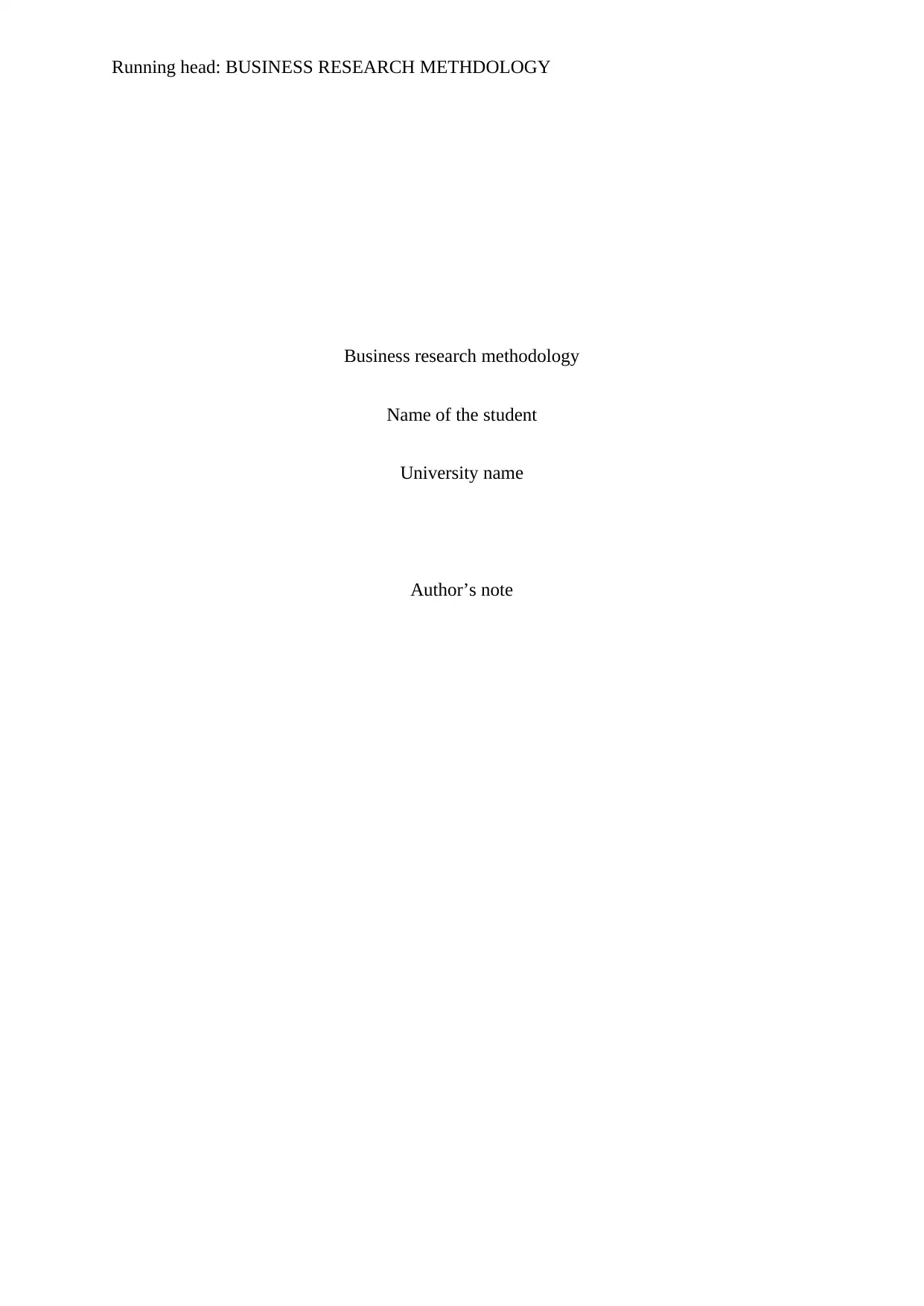
Running head: BUSINESS RESEARCH METHDOLOGY
Business research methodology
Name of the student
University name
Author’s note
Business research methodology
Name of the student
University name
Author’s note
Paraphrase This Document
Need a fresh take? Get an instant paraphrase of this document with our AI Paraphraser
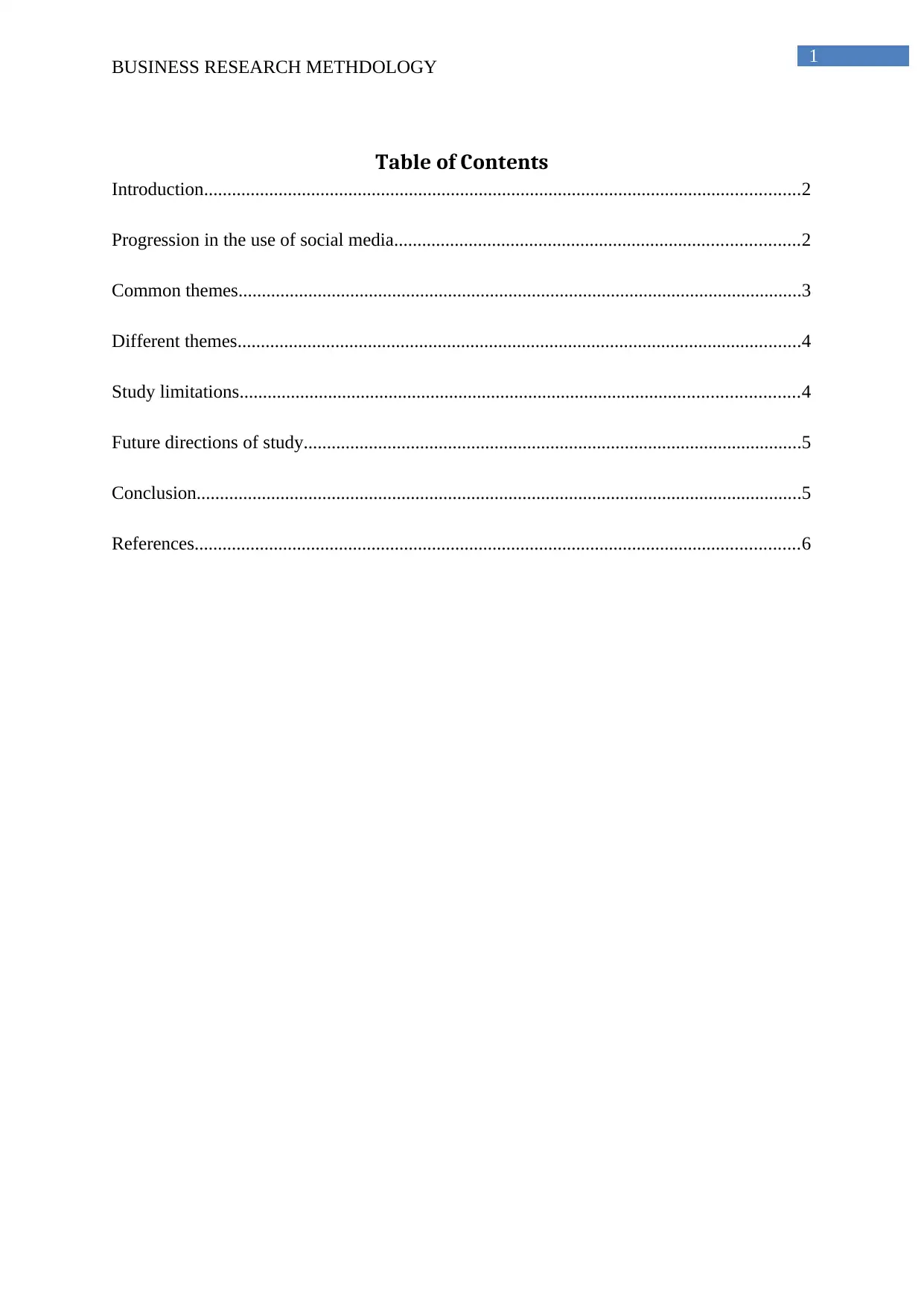
1
BUSINESS RESEARCH METHDOLOGY
Table of Contents
Introduction................................................................................................................................2
Progression in the use of social media.......................................................................................2
Common themes.........................................................................................................................3
Different themes.........................................................................................................................4
Study limitations........................................................................................................................4
Future directions of study...........................................................................................................5
Conclusion..................................................................................................................................5
References..................................................................................................................................6
BUSINESS RESEARCH METHDOLOGY
Table of Contents
Introduction................................................................................................................................2
Progression in the use of social media.......................................................................................2
Common themes.........................................................................................................................3
Different themes.........................................................................................................................4
Study limitations........................................................................................................................4
Future directions of study...........................................................................................................5
Conclusion..................................................................................................................................5
References..................................................................................................................................6
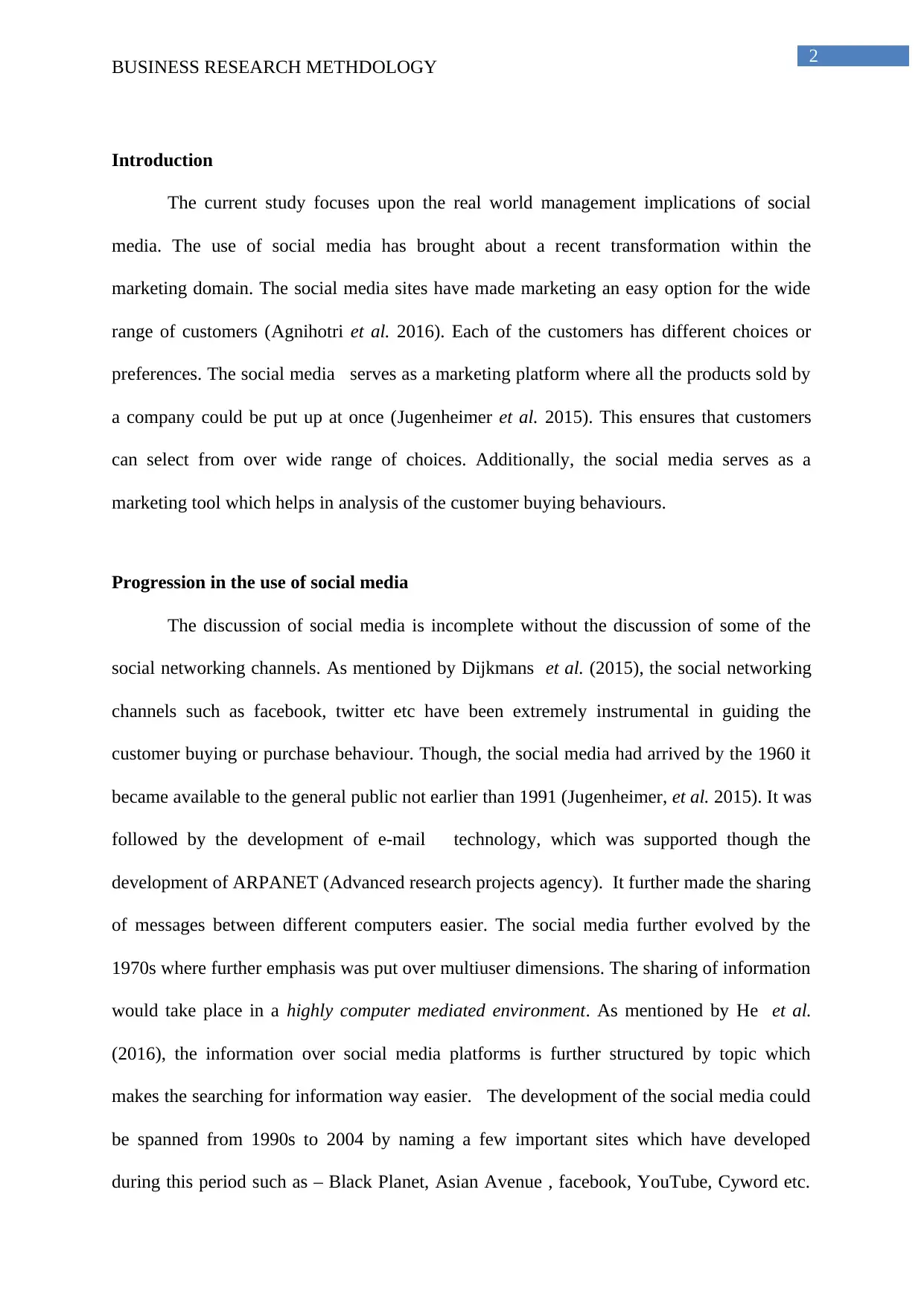
2
BUSINESS RESEARCH METHDOLOGY
Introduction
The current study focuses upon the real world management implications of social
media. The use of social media has brought about a recent transformation within the
marketing domain. The social media sites have made marketing an easy option for the wide
range of customers (Agnihotri et al. 2016). Each of the customers has different choices or
preferences. The social media serves as a marketing platform where all the products sold by
a company could be put up at once (Jugenheimer et al. 2015). This ensures that customers
can select from over wide range of choices. Additionally, the social media serves as a
marketing tool which helps in analysis of the customer buying behaviours.
Progression in the use of social media
The discussion of social media is incomplete without the discussion of some of the
social networking channels. As mentioned by Dijkmans et al. (2015), the social networking
channels such as facebook, twitter etc have been extremely instrumental in guiding the
customer buying or purchase behaviour. Though, the social media had arrived by the 1960 it
became available to the general public not earlier than 1991 (Jugenheimer, et al. 2015). It was
followed by the development of e-mail technology, which was supported though the
development of ARPANET (Advanced research projects agency). It further made the sharing
of messages between different computers easier. The social media further evolved by the
1970s where further emphasis was put over multiuser dimensions. The sharing of information
would take place in a highly computer mediated environment. As mentioned by He et al.
(2016), the information over social media platforms is further structured by topic which
makes the searching for information way easier. The development of the social media could
be spanned from 1990s to 2004 by naming a few important sites which have developed
during this period such as – Black Planet, Asian Avenue , facebook, YouTube, Cyword etc.
BUSINESS RESEARCH METHDOLOGY
Introduction
The current study focuses upon the real world management implications of social
media. The use of social media has brought about a recent transformation within the
marketing domain. The social media sites have made marketing an easy option for the wide
range of customers (Agnihotri et al. 2016). Each of the customers has different choices or
preferences. The social media serves as a marketing platform where all the products sold by
a company could be put up at once (Jugenheimer et al. 2015). This ensures that customers
can select from over wide range of choices. Additionally, the social media serves as a
marketing tool which helps in analysis of the customer buying behaviours.
Progression in the use of social media
The discussion of social media is incomplete without the discussion of some of the
social networking channels. As mentioned by Dijkmans et al. (2015), the social networking
channels such as facebook, twitter etc have been extremely instrumental in guiding the
customer buying or purchase behaviour. Though, the social media had arrived by the 1960 it
became available to the general public not earlier than 1991 (Jugenheimer, et al. 2015). It was
followed by the development of e-mail technology, which was supported though the
development of ARPANET (Advanced research projects agency). It further made the sharing
of messages between different computers easier. The social media further evolved by the
1970s where further emphasis was put over multiuser dimensions. The sharing of information
would take place in a highly computer mediated environment. As mentioned by He et al.
(2016), the information over social media platforms is further structured by topic which
makes the searching for information way easier. The development of the social media could
be spanned from 1990s to 2004 by naming a few important sites which have developed
during this period such as – Black Planet, Asian Avenue , facebook, YouTube, Cyword etc.
⊘ This is a preview!⊘
Do you want full access?
Subscribe today to unlock all pages.

Trusted by 1+ million students worldwide
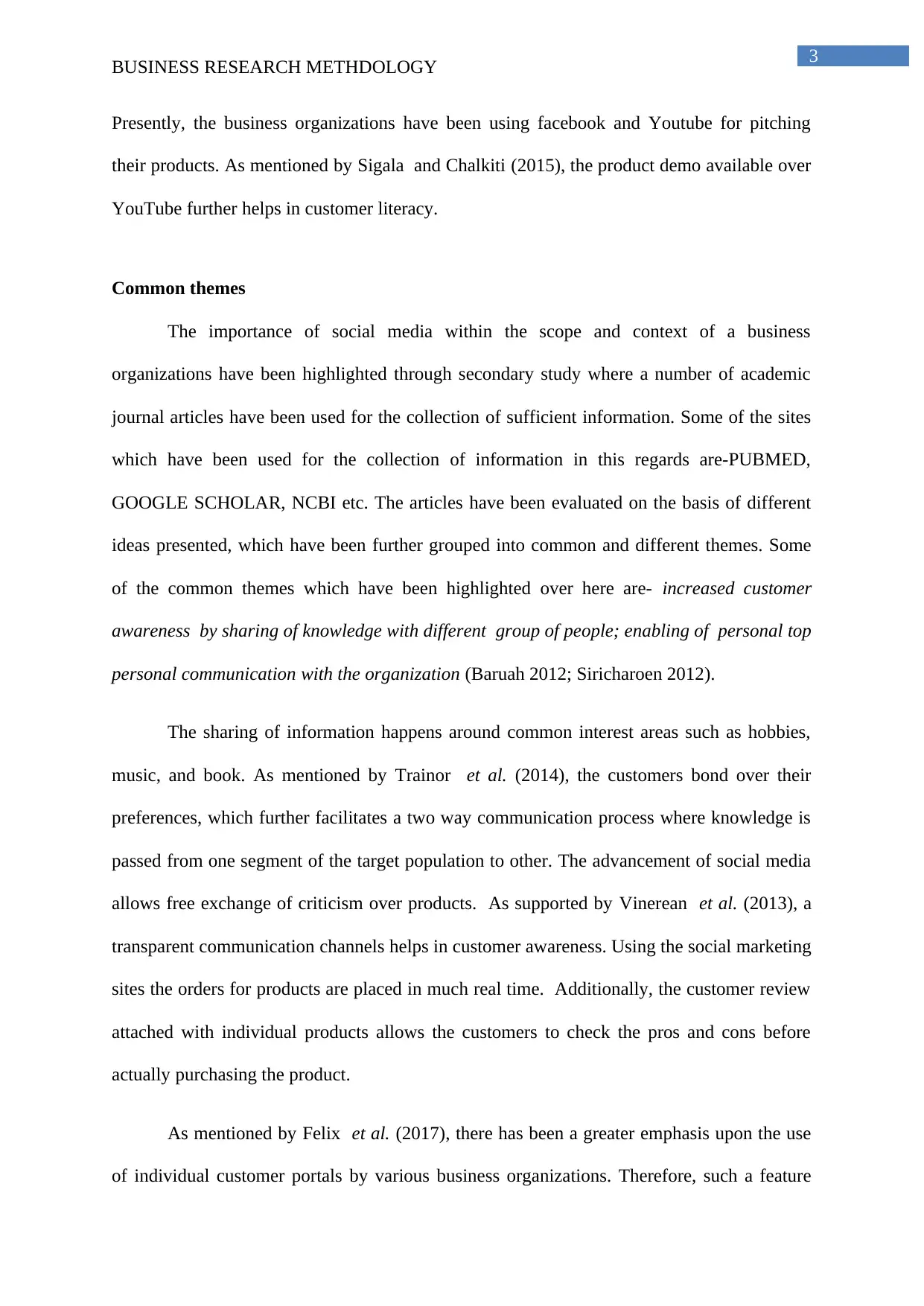
3
BUSINESS RESEARCH METHDOLOGY
Presently, the business organizations have been using facebook and Youtube for pitching
their products. As mentioned by Sigala and Chalkiti (2015), the product demo available over
YouTube further helps in customer literacy.
Common themes
The importance of social media within the scope and context of a business
organizations have been highlighted through secondary study where a number of academic
journal articles have been used for the collection of sufficient information. Some of the sites
which have been used for the collection of information in this regards are-PUBMED,
GOOGLE SCHOLAR, NCBI etc. The articles have been evaluated on the basis of different
ideas presented, which have been further grouped into common and different themes. Some
of the common themes which have been highlighted over here are- increased customer
awareness by sharing of knowledge with different group of people; enabling of personal top
personal communication with the organization (Baruah 2012; Siricharoen 2012).
The sharing of information happens around common interest areas such as hobbies,
music, and book. As mentioned by Trainor et al. (2014), the customers bond over their
preferences, which further facilitates a two way communication process where knowledge is
passed from one segment of the target population to other. The advancement of social media
allows free exchange of criticism over products. As supported by Vinerean et al. (2013), a
transparent communication channels helps in customer awareness. Using the social marketing
sites the orders for products are placed in much real time. Additionally, the customer review
attached with individual products allows the customers to check the pros and cons before
actually purchasing the product.
As mentioned by Felix et al. (2017), there has been a greater emphasis upon the use
of individual customer portals by various business organizations. Therefore, such a feature
BUSINESS RESEARCH METHDOLOGY
Presently, the business organizations have been using facebook and Youtube for pitching
their products. As mentioned by Sigala and Chalkiti (2015), the product demo available over
YouTube further helps in customer literacy.
Common themes
The importance of social media within the scope and context of a business
organizations have been highlighted through secondary study where a number of academic
journal articles have been used for the collection of sufficient information. Some of the sites
which have been used for the collection of information in this regards are-PUBMED,
GOOGLE SCHOLAR, NCBI etc. The articles have been evaluated on the basis of different
ideas presented, which have been further grouped into common and different themes. Some
of the common themes which have been highlighted over here are- increased customer
awareness by sharing of knowledge with different group of people; enabling of personal top
personal communication with the organization (Baruah 2012; Siricharoen 2012).
The sharing of information happens around common interest areas such as hobbies,
music, and book. As mentioned by Trainor et al. (2014), the customers bond over their
preferences, which further facilitates a two way communication process where knowledge is
passed from one segment of the target population to other. The advancement of social media
allows free exchange of criticism over products. As supported by Vinerean et al. (2013), a
transparent communication channels helps in customer awareness. Using the social marketing
sites the orders for products are placed in much real time. Additionally, the customer review
attached with individual products allows the customers to check the pros and cons before
actually purchasing the product.
As mentioned by Felix et al. (2017), there has been a greater emphasis upon the use
of individual customer portals by various business organizations. Therefore, such a feature
Paraphrase This Document
Need a fresh take? Get an instant paraphrase of this document with our AI Paraphraser

4
BUSINESS RESEARCH METHDOLOGY
helps in building a priority based bond with the customers. The direct channels also help in
the lodging of complaints regarding individual services and products. Additionally, the
facilitated communication approaches allows the business houses to understand the customer
needs and demands and resolve the issues related with the service in much real time.
Different themes
The evaluation of the papers also helped in highlighting the different themes which
have been further discussed over here. Some of the themes which have emerged in the current
process are - introducing a more creative interface over social media; enhancing online
customer engagement (Vinerean et al. 2013; Derani and Naidu 2016).
This places much importance over the use marketing gimmicks and strategies such as
search engine optimization (SEO). The SEO is based upon increasing the traffic of individual
WebPages by attracting more number of customers. As mentioned by Siricharoen (2012),
ever customer would like to reach a webpage with the information presented in a much
structured and coherent manner. The current era is based upon using features such as pay
per click which are further used to increase the popularity attached with every product.
Study limitations
The study conducted possessed a number of limitations which have been further
elaborated over here. The data here has been collected through mixed methods where both
primary survey design and secondary thematic approach has been used.
For instance, the small size of the focus groups has further led to limited data or
erroneous results being generated. As mentioned by Vinerean et al. (2013), the unsystematic
sampling also affected the quality of the results. The secondary data collected through
websites could be erroneous which could again affect the quality of the result.
BUSINESS RESEARCH METHDOLOGY
helps in building a priority based bond with the customers. The direct channels also help in
the lodging of complaints regarding individual services and products. Additionally, the
facilitated communication approaches allows the business houses to understand the customer
needs and demands and resolve the issues related with the service in much real time.
Different themes
The evaluation of the papers also helped in highlighting the different themes which
have been further discussed over here. Some of the themes which have emerged in the current
process are - introducing a more creative interface over social media; enhancing online
customer engagement (Vinerean et al. 2013; Derani and Naidu 2016).
This places much importance over the use marketing gimmicks and strategies such as
search engine optimization (SEO). The SEO is based upon increasing the traffic of individual
WebPages by attracting more number of customers. As mentioned by Siricharoen (2012),
ever customer would like to reach a webpage with the information presented in a much
structured and coherent manner. The current era is based upon using features such as pay
per click which are further used to increase the popularity attached with every product.
Study limitations
The study conducted possessed a number of limitations which have been further
elaborated over here. The data here has been collected through mixed methods where both
primary survey design and secondary thematic approach has been used.
For instance, the small size of the focus groups has further led to limited data or
erroneous results being generated. As mentioned by Vinerean et al. (2013), the unsystematic
sampling also affected the quality of the results. The secondary data collected through
websites could be erroneous which could again affect the quality of the result.

5
BUSINESS RESEARCH METHDOLOGY
Future directions of study
The limitations discovered through the study methods over here could be further
expanded upon in the future. Some of the research articles failed to take into consideration
are the demographics such as the age, gender of the respondents, which further guide the
choice or the preferences (Derani and Naidu 2016). Some of the papers also failed to take
into consideration factors such as the researcher’s biases.
Conclusion
The social media help in the development of sufficient customer awareness.
Therefore, developing a clear idea regarding the customer buying behaviour can help the
business organizations in developing an effective marketing plan. The social media serves as
a useful psychoanalytic tool which helps in understanding the various factors which triggers a
particular kind of buying approach within people (Parveen et al., 2015). This is used by the
business organizations in pitching of their products. Additionally, a clear and transparent
communication interface helps in promoting objectives such as customer loyalty.
BUSINESS RESEARCH METHDOLOGY
Future directions of study
The limitations discovered through the study methods over here could be further
expanded upon in the future. Some of the research articles failed to take into consideration
are the demographics such as the age, gender of the respondents, which further guide the
choice or the preferences (Derani and Naidu 2016). Some of the papers also failed to take
into consideration factors such as the researcher’s biases.
Conclusion
The social media help in the development of sufficient customer awareness.
Therefore, developing a clear idea regarding the customer buying behaviour can help the
business organizations in developing an effective marketing plan. The social media serves as
a useful psychoanalytic tool which helps in understanding the various factors which triggers a
particular kind of buying approach within people (Parveen et al., 2015). This is used by the
business organizations in pitching of their products. Additionally, a clear and transparent
communication interface helps in promoting objectives such as customer loyalty.
⊘ This is a preview!⊘
Do you want full access?
Subscribe today to unlock all pages.

Trusted by 1+ million students worldwide
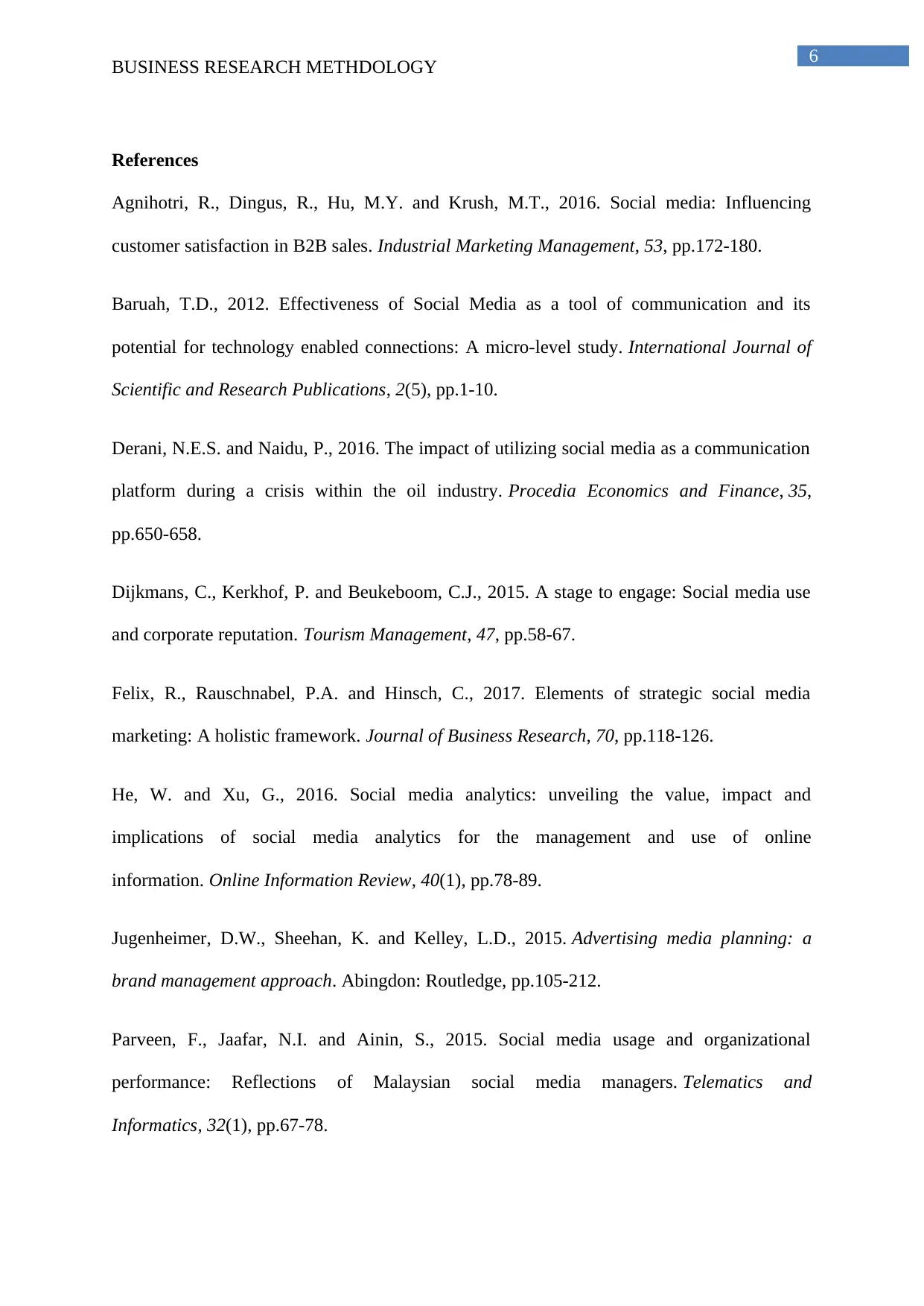
6
BUSINESS RESEARCH METHDOLOGY
References
Agnihotri, R., Dingus, R., Hu, M.Y. and Krush, M.T., 2016. Social media: Influencing
customer satisfaction in B2B sales. Industrial Marketing Management, 53, pp.172-180.
Baruah, T.D., 2012. Effectiveness of Social Media as a tool of communication and its
potential for technology enabled connections: A micro-level study. International Journal of
Scientific and Research Publications, 2(5), pp.1-10.
Derani, N.E.S. and Naidu, P., 2016. The impact of utilizing social media as a communication
platform during a crisis within the oil industry. Procedia Economics and Finance, 35,
pp.650-658.
Dijkmans, C., Kerkhof, P. and Beukeboom, C.J., 2015. A stage to engage: Social media use
and corporate reputation. Tourism Management, 47, pp.58-67.
Felix, R., Rauschnabel, P.A. and Hinsch, C., 2017. Elements of strategic social media
marketing: A holistic framework. Journal of Business Research, 70, pp.118-126.
He, W. and Xu, G., 2016. Social media analytics: unveiling the value, impact and
implications of social media analytics for the management and use of online
information. Online Information Review, 40(1), pp.78-89.
Jugenheimer, D.W., Sheehan, K. and Kelley, L.D., 2015. Advertising media planning: a
brand management approach. Abingdon: Routledge, pp.105-212.
Parveen, F., Jaafar, N.I. and Ainin, S., 2015. Social media usage and organizational
performance: Reflections of Malaysian social media managers. Telematics and
Informatics, 32(1), pp.67-78.
BUSINESS RESEARCH METHDOLOGY
References
Agnihotri, R., Dingus, R., Hu, M.Y. and Krush, M.T., 2016. Social media: Influencing
customer satisfaction in B2B sales. Industrial Marketing Management, 53, pp.172-180.
Baruah, T.D., 2012. Effectiveness of Social Media as a tool of communication and its
potential for technology enabled connections: A micro-level study. International Journal of
Scientific and Research Publications, 2(5), pp.1-10.
Derani, N.E.S. and Naidu, P., 2016. The impact of utilizing social media as a communication
platform during a crisis within the oil industry. Procedia Economics and Finance, 35,
pp.650-658.
Dijkmans, C., Kerkhof, P. and Beukeboom, C.J., 2015. A stage to engage: Social media use
and corporate reputation. Tourism Management, 47, pp.58-67.
Felix, R., Rauschnabel, P.A. and Hinsch, C., 2017. Elements of strategic social media
marketing: A holistic framework. Journal of Business Research, 70, pp.118-126.
He, W. and Xu, G., 2016. Social media analytics: unveiling the value, impact and
implications of social media analytics for the management and use of online
information. Online Information Review, 40(1), pp.78-89.
Jugenheimer, D.W., Sheehan, K. and Kelley, L.D., 2015. Advertising media planning: a
brand management approach. Abingdon: Routledge, pp.105-212.
Parveen, F., Jaafar, N.I. and Ainin, S., 2015. Social media usage and organizational
performance: Reflections of Malaysian social media managers. Telematics and
Informatics, 32(1), pp.67-78.
Paraphrase This Document
Need a fresh take? Get an instant paraphrase of this document with our AI Paraphraser
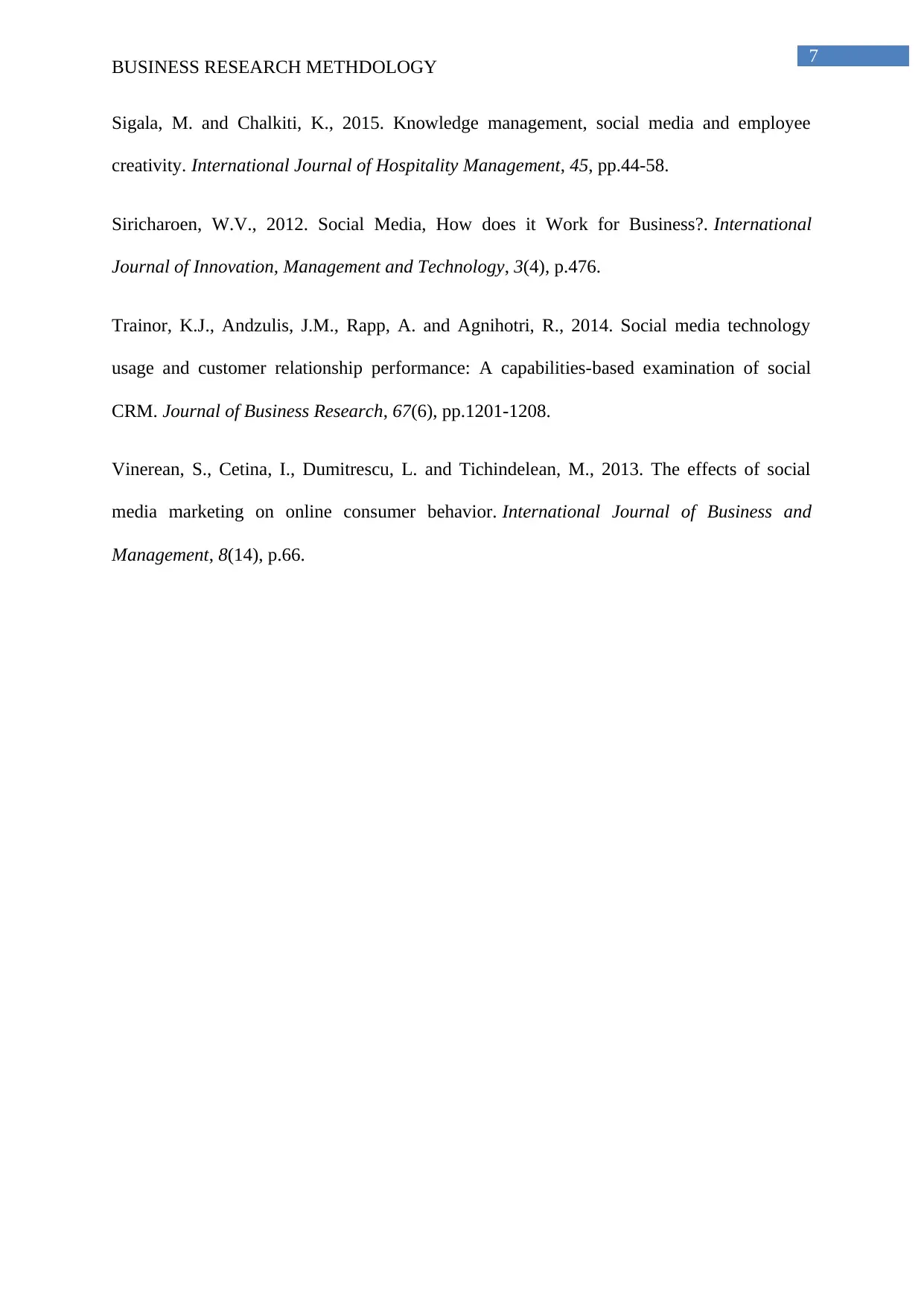
7
BUSINESS RESEARCH METHDOLOGY
Sigala, M. and Chalkiti, K., 2015. Knowledge management, social media and employee
creativity. International Journal of Hospitality Management, 45, pp.44-58.
Siricharoen, W.V., 2012. Social Media, How does it Work for Business?. International
Journal of Innovation, Management and Technology, 3(4), p.476.
Trainor, K.J., Andzulis, J.M., Rapp, A. and Agnihotri, R., 2014. Social media technology
usage and customer relationship performance: A capabilities-based examination of social
CRM. Journal of Business Research, 67(6), pp.1201-1208.
Vinerean, S., Cetina, I., Dumitrescu, L. and Tichindelean, M., 2013. The effects of social
media marketing on online consumer behavior. International Journal of Business and
Management, 8(14), p.66.
BUSINESS RESEARCH METHDOLOGY
Sigala, M. and Chalkiti, K., 2015. Knowledge management, social media and employee
creativity. International Journal of Hospitality Management, 45, pp.44-58.
Siricharoen, W.V., 2012. Social Media, How does it Work for Business?. International
Journal of Innovation, Management and Technology, 3(4), p.476.
Trainor, K.J., Andzulis, J.M., Rapp, A. and Agnihotri, R., 2014. Social media technology
usage and customer relationship performance: A capabilities-based examination of social
CRM. Journal of Business Research, 67(6), pp.1201-1208.
Vinerean, S., Cetina, I., Dumitrescu, L. and Tichindelean, M., 2013. The effects of social
media marketing on online consumer behavior. International Journal of Business and
Management, 8(14), p.66.

8
BUSINESS RESEARCH METHDOLOGY
BUSINESS RESEARCH METHDOLOGY
⊘ This is a preview!⊘
Do you want full access?
Subscribe today to unlock all pages.

Trusted by 1+ million students worldwide
1 out of 9
Related Documents
Your All-in-One AI-Powered Toolkit for Academic Success.
+13062052269
info@desklib.com
Available 24*7 on WhatsApp / Email
![[object Object]](/_next/static/media/star-bottom.7253800d.svg)
Unlock your academic potential
Copyright © 2020–2025 A2Z Services. All Rights Reserved. Developed and managed by ZUCOL.





